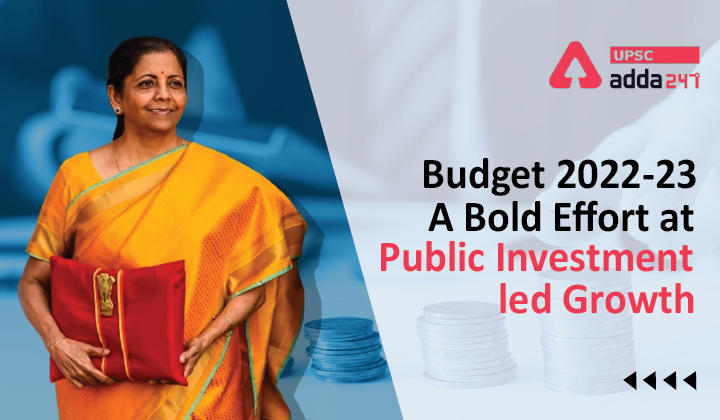Table of Contents
Union Budget 2022-23: Relevance for UPSC Exam
- GS Paper 3: Indian Economy– Issues relating to planning, mobilization of resources, growth, development and employment; Government Budgeting.
Union Budget 2022-23: Context
- Recently, the Union Budget tabled in Parliament saying that India’s domestic output (GDP) is likely to grow 9.2% this year (2021-22) over last year- the highest among the world’s large economies.
- However, India’s output contraction in the previous year (2020-21) was among the worst in the world.
Get Free Study Material for UPSC and State PCS Examinations
Union Budget 2022-23: Budgetary Provisions
- Union Budget 2022-23 seeks to boost public investment by 35.4% at current prices over last year to raise its share in GDP to 2.9% from 2.2% last year.
- With grant-in-aid for state investments, the Union Budget hopes to increase public investment share to over 4% of GDP.
- The Union Budget hopes to trigger a virtuous investment-led output and employment growth.
- This will happen through the “crowding-in” effect of public investment on private investment.
- The Union Budget 2022-23 aims to mobilise resources to finance the investment as it seeks to reduce the fiscal deficit ratio, as per the schedule laid out in the last Budget.
Decoding Union Budget 2022-23 | Tourism Sector
Union Budget 2022-23: Challenges to Indian Economy
- COVID Virus: adverse effect of the ongoing wave of the Omicron virus may negatively impact the rise in GDP (estimated to be 9.1% this year by Economic Survey).
- No growth in Per Capita Income: India lost two years of output expansion. In other words, per capita income, today is lower than it was two years ago.
- Decline in Private Consumption: the share of private consumption declined by three percentage points of GDP between FY2020 and FY2022.
- The Government stepped up its expenditure to mitigate the decline, but only modestly; hence, the marginal output expansion.
- Issue of Revenue Realization: The critical question is whether additional tax and non-tax revenue (that is disinvestment proceeds) will be sufficient to finance the investment plan.
- public investment has picked up in the current fiscal, by barely 0.2% of GDP.
- Challenges in meeting the proposed investment targets:
- Threat of higher (imported) inflation (on account of rising international oil prices) and
- Rising interest rates (on account of the US Federal Reserve’s decision).
- Rising Unemployment: Rampant loss of employment is probably one of the key causes of the decline (of three percentage points of GDP) in private consumption.
- Industrial Slowdown: The manufacturing sector’s share in GDP has been stagnating at around 15% of GDP for quite a while.
- The annual industrial growth rate has sharply slowed down from 13.1% in 2015-16 to minus 7.2% in 2020-21.
- Another example, of the industrial slowdown, is the fall in two-wheeler sales. As per news reports, it fell to 11.77 million units in 2021, below 11.90 million units sold in 2014.
- Industrial slowdown leads to a contraction in employment, mostly in the informal or unorganized sector.
Decoding Union Budget 2022-23 | PM Gati Shakti National Master Plan
Union Budget 2022-23 on Public Investment: Way Forward
- Ensuring Revenue realization: The realization of revenue for the proposed public investments would crucially depend on-
- Tax revenue realisations,
- Disinvestment proceeds,
- Sale of rail and road assets and
- Government’s ability to raise resources from the market, without raising interest rates for the private sector.
- Employment: enhanced allocation for the Mahatma Gandhi National Rural Employment Guarantee Act (MGNREGA) and initiating a similar scheme for meeting urban unemployment.
- However, the Government has slashed the allocation for MGNREGA by 25% over last year.
- Reducing Imports: If a substantial share of proposed public investment “leaks” out as imports, then the industrial output may not get the desired boost.
Analysis of Sansad TV Discussion: ”Union Budget 2022-23: Amrit Kaal”
Union Budget 2022-23: Conclusion
- Without fully committed funds for capital investment, the success of the ambitious effort to fund proposed public investment remains questionable.
Union Budget 2022-23 | Union Budget 2022-23 Highlights | Part A
Union Budget 2022-23 | Union Budget 2022-23 Highlights | Part B




 TSPSC Group 1 Question Paper 2024, Downl...
TSPSC Group 1 Question Paper 2024, Downl...
 TSPSC Group 1 Answer key 2024 Out, Downl...
TSPSC Group 1 Answer key 2024 Out, Downl...
 UPSC Prelims 2024 Question Paper, Downlo...
UPSC Prelims 2024 Question Paper, Downlo...




